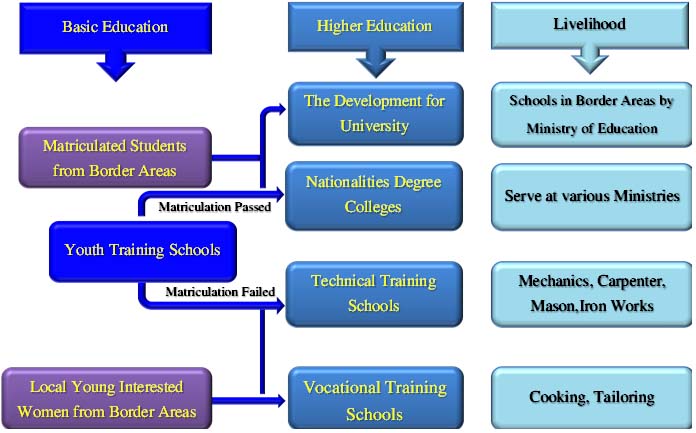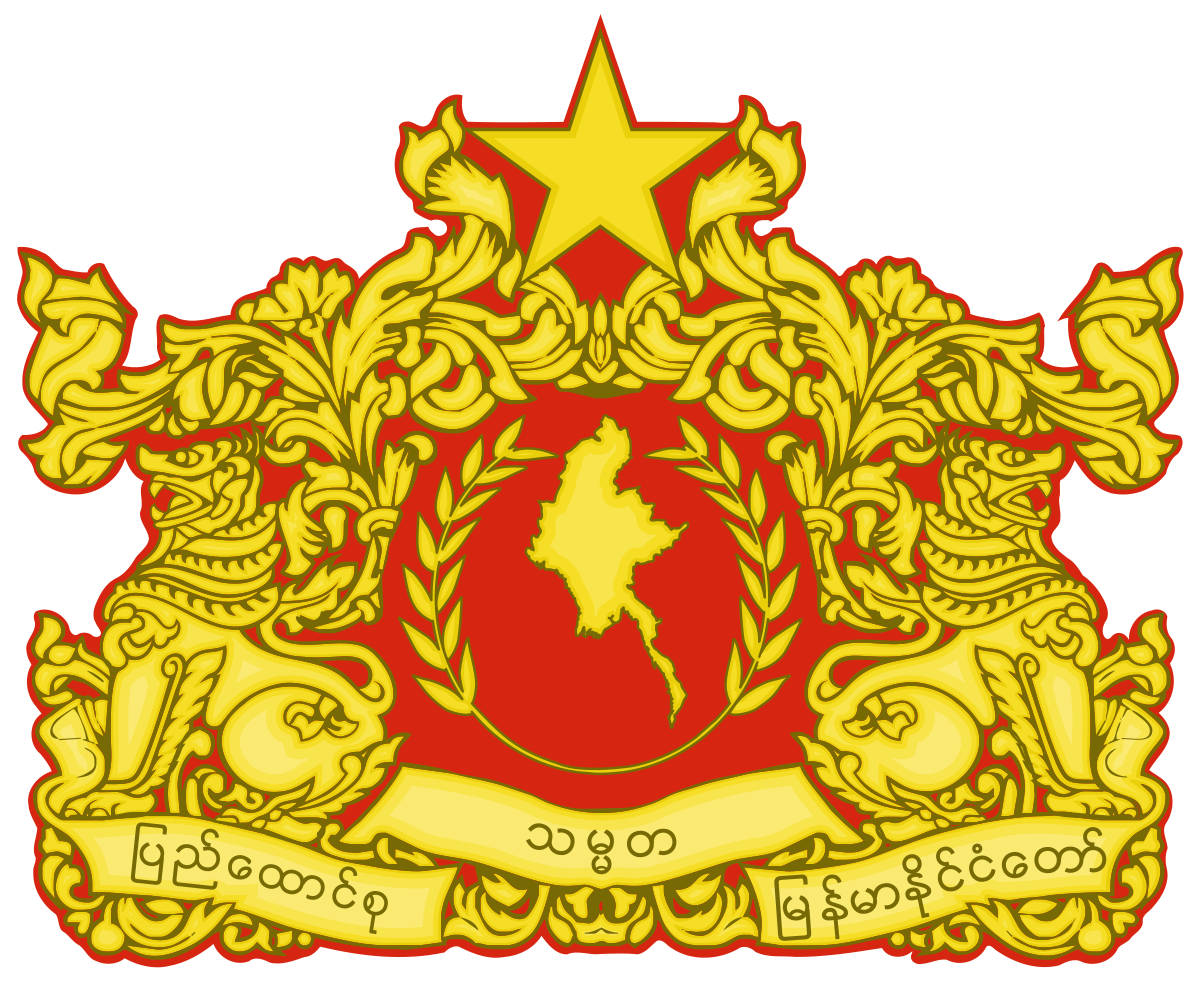Ministry of Border Affairs
- Ministry of Transport and Communications
- Ministry of Defense
- Ministry of Home Affairs
- Ministry of Planning and Finance
- Ministry of Foreign Affairs
- Ministry of Union Government Office (1)
- Ministry of Union Government Office (2)
- Ministry of Border Affairs
- Ministry of Investment and Foreign Economic Relations
- Ministry of Legal Affairs
- Ministry of Information
- Ministry of Religious Affairs & Culture
- Ministry of Agriculture, Livestock and Irrigation
- Ministry of Natural Resources & Environmental Conservation
- Ministry of Electric Power
- Ministry of Energy
- Ministry of Industry
- Ministry of Immigration & Population
- Ministry of Labour
- Ministry of Commerce
- Ministry of Education
- Ministry of Science and Technology
- Ministry of Sports and Youth Affairs
- Ministry of Construction
- Ministry of Social Welfare, Relief & Resettlement
- Ministry of Hotel & Tourism
- Ministry of Ethnic Affairs
Ministry of Border Affairs
Background History
- After gaining independence, based upon difference in ism, difference in thought and geographical situations, there emerged internal armed groups. Although successive governments have genuine desire to carry out border areas development measures, these measures could not be fully implemented for lack of regional peace and stability and for difficulty in transportation and communications and then only peace and stability were prioritized and carried out.
- Since after some ethnic armed groups came into the legal fold in 1989, the government carried out border areas development measures with added momentum. When ethnic armed groups were aware of the development of the border areas where they live, they realized their armed process and knew their sustainable livelihood, uplift in socio-economic condition and true genuine goodwill of the government and they came into the legal fold one after another.
- As (17) big ethnic armed groups and (23) small ethnic armed groups have come into the legal fold after 1989, the government formed the Central Committee for the Implementation of the Development of Border Areas and National Races and the Central Committee took the responsibility for border areas development measures which have lagged far behind in successive eras so that there will be no gap between the border areas and mainland areas. However, there needed one ministry that can take responsibility for implementing such widespread broder areas development measures and starting from this necessity, Ministry of Border Affairs was established and appeared and the change steps in the establishment of the ministry are as follows:
- Ministry for Progress of Border of Border Areas and National Races was established on 24th September, 1992.
- Ministry for Progress of Border Areas and National Races and Development Affairs was established on 30th January, 1994.
- Ministry of Border Affairs was reestablished on 30th March, 2011 respectively.
The Policies of the Ministry
4. The Policies of the ministry are as follows:-
i. Stability and tranquility in the border areas;
ii. Development of the border areas;
iii. Development of socio-economic condition of the people in border areas;
iv. Development of human resources of national races of border areas.
The Visions of the Ministry
5. The Visions of the ministry are as follows:-
i. To preserve and maintain the security, prevalence of law and order and regional peace and tranquility of the border areas.
ii. To further strengthen the amity among the national races and to build the Union spirit;
iii. To uplift the socio-economic development of national races by establishing basic infrastructure for border areas development;
iv. To cherish and preserve the culture, literature and customs of the national races;
v. To propagate religion and dispensation in the border areas;
vi. To pursue the basic, higher and livelihood trainings for the future of nationalities youths;
vii. To let the nationalities youths shoulder their regional development measures with their own sense.
The Functions of the Ministry
6. The Functions of the Ministry are as follows:-
i. To designate special development zones for the development of border areas and national races;
ii. To draw up the long-term and short-term plans for the development of national races residing in border areas;
iii. To implement the long-term and short-term plans which are confirmed by the Central Committee for the Implemention of the Development of Border Areas and National Races;
iv. To implement the development works which have been prescribed for immediate performance by the Central committee for the Implementation of the Development of Border Areas and National Races;
v. To implement socio-economic infrastructure for the border areas with annual plans such as:
(a) Roads and bridges sector;
(b) Water Supply sector;
(i) Water supply for agriculture
(ii) Water supply for drinking water
(c ) Electricity sector;
(i) Hydro-power
(ii) Solar power system
(d) Religious Affairs;
(e ) Construction works for peace:
i. Roads and Bridges;
ii. Education;
iii. Health;
iv. Housing;
vi. The Nationalities youths in border areas are given free of charge from the basic education middle school to the basic education high school.
vii. To pursue higher education for the nationalities youths who pass the basic education high school to have opportunities to study the courses in the University for the Development of the National Races of the Union and Nationalities Youths Resource Development Degree Colleges.
viii. To consolidate the Union Spirit and amity among the nationalities youths while studying together at the college and to understand and cherish the culture, traditions, good customs and practices of national races.
ix. To nurture all national people to constantly safeguard non-disintegration of the union,non-disintegration of national solidarity and perpetuation of sovereignty.
x. To assign the graduates in the appropriate tasks associated with the development works in various ministries after attaining the higher education.
xi. To nurture young national races women from the border areas, vocational expertise and assist earning in establishing micro-business opportunities.
xii. To emerge local skillful workmen among the national races by conducting technical training for them and to promote micro-enterprises and micro-industries.
xiii. To lay down programmes for disseminating knowledge and exchanging culture for the national races in the Development Areas.
xiv. To carry out national affairs as a priority in accordance with the desire of Nationalities Youths.
xv. To make arrangements for the promotion and propagation of the sasana in the border areas.
xvi. To make arrangements for establishing crops cultivation, livestock breeding and cottage industries in substitution for poppy cultivation.
xvii. To protect and preserve border boundary pillars and markers.
xviii. To administer for cooperating with UN Agencies, International Organizations, Local Organizations and personnel for more effective implementation of the processes of development of border areas and human resources development.
Structure of Ministry of Border Affairs
7. Ministry of Border Affairs is established in the under-mentioned structure;
a. Minister's Office
b. Progress of Border Areas and National Races Department
c. Education and Training Department

Progress of Border Areas and National Races Department
8. Progress of Border Areas and National Races Department has been carrying out regional development measures and measures for socio-economic development of the people in border areas in (116) townships of (7) States, (2) Regions, (1) Self-Administered Region and (5) Self-Administered Zones and in (52) townships according to work necessity and thus, these measures are being implemented in a total of (168) townships and also in the Regions that are necessary to be implemented due to instructions made by the state level personnel, submissions by Region/State Governments and submissions by Htuttaw Representatives.
9. The entitled works in implementing border areas development measures are as follows;
a. Roads/Bridges sector;
b. Education sector;
c. Health sector;
d. Agriculture sector;
e. Drinking water supply sector;
f. Energy sector;
g. Public relation sector;
h. Religious affairs sector;
i. Housing sector.
10. Under Progress of Border Areas and National Races Department, the Department (Headquarters) and Regions/States Development Supervisory Offices are established as follows;
Regions/States Development Supervisory Offices
|
Sr.No |
Region |
State/Region Development Supervisory Office |
State Branch Office |
District Development Supervisory Office |
Township Development Supervisory Office |
|
1. |
Myitkyina |
1 |
|
2 |
7 |
|
2. |
Taunggyi |
1 |
2 |
7 |
18 |
|
3. |
Loikaw |
1 |
|
1 |
4 |
|
4. |
Pha-an |
1 |
|
2 |
5 |
|
5. |
Mawlamyine |
1 |
|
1 |
5 |
|
6. |
Dawae |
1 |
|
2 |
3 |
|
7. |
Sittway |
1 |
|
3 |
6 |
|
8. |
Monywa |
1 |
|
3 |
5 |
|
9. |
Hakha |
1 |
|
2 |
4 |
|
10. |
Meikhtilar |
|
|
1 |
|
|
11. |
Yangon |
|
|
1 |
0 |
|
|
Total |
9 |
2 |
25 |
57 |
Education and Training Department
11. Education and Training Department was established under Ministry of Border Affairs on 30th June, 1999 with the purposes of promoting and teaching basic and higher educational subjects to the nationalities youths from border areas and training and nurturing them to be intellectuals and intelligentsia who can serve for the development of their regions and providing vocational domestic science courses for young women from border areas and the Department is established as follows;
- The Department (Head Office);
- University for the Development of the National Races of the Union;
- Nationalities Youths Resource Development Degree Colleges;
- Central Training School;
- 45 Training Schools for Development of Nationalities Youths from Border Areas;
- 9 Technical Schools for Nationalities Youths from Border Areas;
g. 45 Vocational Training Schools of Domestic Science for Women.
Locations of Training Schools for Development of Nationalities Youths from Border Areas
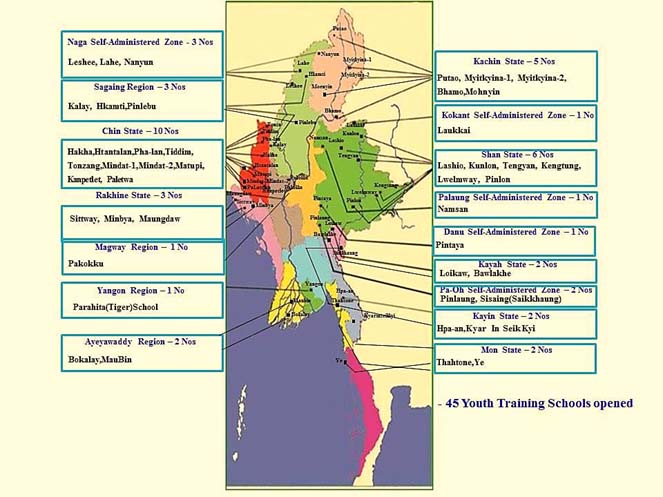
Locations of Technical Schools for Nationalities Youths from Border Areas
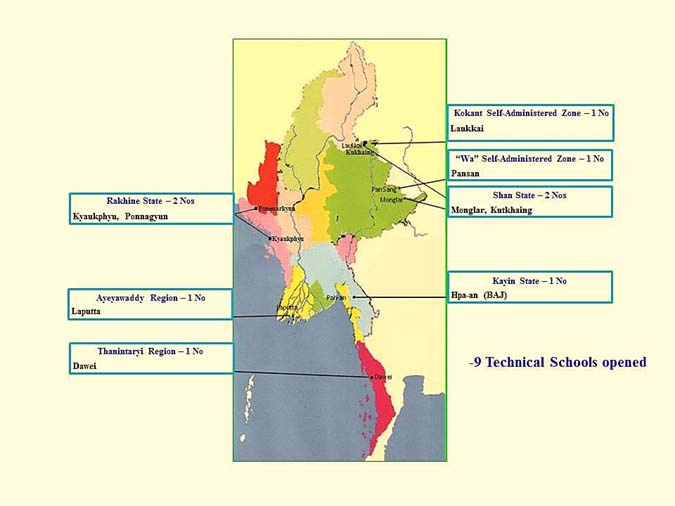
Remarks: Technical Schools for Nationalities Youths from Border Areas (Pansan) and (Monglar) have temporarily stopped for opening trainings due to the area situation.
Locations of Vocational Training Schools of Domestic Science for Women
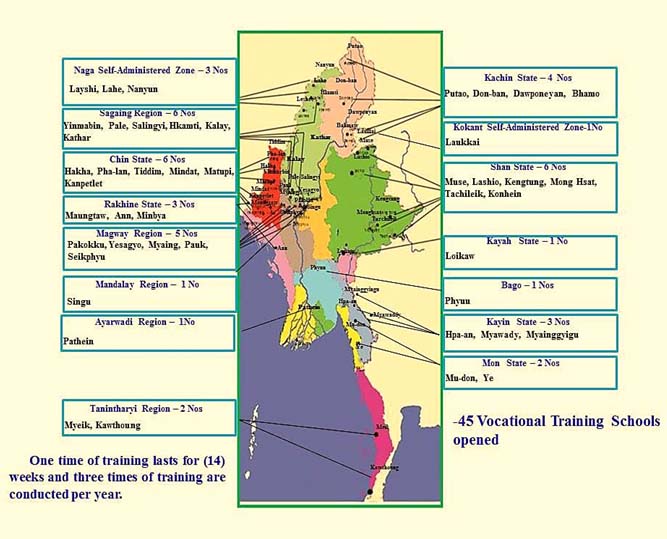
Processes for human resources development implemented by Education and Training Department

